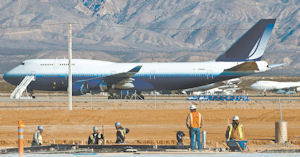Construction is underway at the Mojave Air & Space Port on hangar and fabrication facilities that will house a mammoth aircraft built to launch space vehicles carrying satellites into orbit. Stratolaunch Systems, founded by billionaire Paul Allen, is the latest commercial space venture to touch down in the desert community 100 miles north of Los Angeles. The Stratolaunch aircraft is made from parts of two 747s and has a wingspan of 385 feet, the longest ever on a single aircraft. Allen, the co-founder of Microsoft Corp., is funding Stratolaunch through his Vulcan Inc., investment firm. And he has turned to three leading companies in the commercial space industry as subcontractors — Scaled Composites, Space Exploration Technologies Corp. (Space X), and Dynetics. Unlike fellow billionaire Sir Richard Branson, whose Virgin Galactic is going after the space tourism market, Allen’s venture could be a game changer if it succeeds in providing a more flexible and less expensive option to carry satellites into space. Currently satellites are taken into space by ground-launched rockets and the commercial launch business has a track record for more failures than successes. Paul Ghaffari, chief investment officer at Vulcan, would not disclose how much Allen was paying for the Mojave facilities. The billionaire is prepared to provide the financing necessary to build the carrier aircraft, test it and begin the missions. “It is like any other venture,” Ghaffari said. “There is an upfront investment on what is potentially a profitable venture.” With only 30 percent of its 3,300 acres occupied, the space port has the room to accommodate the Stratolaunch facilities, said Stuart Witt, CEO and general manager of the Mojave Air & Space Port. Workers have finished pouring the foundation for the 90,000-square-foot fabrication building and begun putting up the walls. The scheduled completion is late 2012. The adjacent hangar, also 90,000 square feet, will be completed in the second half of the year with occupancy in mid-2013, Ghaffari said. Team Stratolaunch While Allen and Vulcan are based in Washington State, Stratolaunch will have its headquarters in Huntsville, Ga. Gary Wentz, a former senior engineer with NASA, is the president and CEO. Former NASA Administrator Mike Griffin is among the board members. Scaled Composites, based in Mojave, will build the carrier aircraft. SpaceX will provide the Falcon 9 rocket carrying the payload, a technical term for cargo aboard the rocket. And Dynetics is the systems integrator. About 100 employees from Scaled Composites, SpaceX, based in Hawthorne, and Dynetics, in Huntsville, Ga., are working on the Stratolaunch aircraft. “We expect to ramp that number up as we complete the design and begin the manufacturing,” Ghaffari said. Stratolaunch is not Allen’s first venture toward the stars. In 2004, he financed SpaceShipOne, the reusable suborbital space vehicle that won the Ansari X Prize. However, what Allen proposes to do with Stratolaunch is more ambitious than the earlier space jet. Six 747 engines will power the 1.2 million pound, twin fuselage carrier aircraft to an altitude of 30,000 feet or higher, where the Falcon 9 rocket will blast off and complete the journey of the cargo into Earth’s orbit. Long term, Stratolaunch also hopes to use the aircraft to put humans into space, Ghaffari said. The Stratolaunch aircraft, which does not yet have a name, would be the world’s largest, eclipsing the Hercules Flying Boat, popularly known as the Spruce Goose, built by billionaire Howard Hughes in the 1940s. That aircraft has a wingspan of 319 feet. The mobility of the aircraft gives Stratolaunch a leg up over the United Launch Alliance, which uses Atlas and Delta rockets to send military satellites into space. The ability to launch from the air removes the constrictions of launch windows and bad weather that ULA faces with its ground-launched rockets, said Greg Autry, an author who has written on the commercial space industry. “This could change the economics of the space industry in a big way,” Autry said. At a price of $200 million per mission, ULA is vulnerable to the low cost competition that Stratolaunch and SpaceX, said Marco A. Caceres, senior analyst and director of space studies for aerospace research firm Teal Group. But smaller companies such as Stratolaunch may find it tough to match the proven reliability of the Delta and Atlas rockets, Caceres said. If a customer has already spent millions on a sophisticated satellite they may not think twice of meeting ULA’s price to send it into orbit, he said. “Paul Allen and (SpaceX founder) Elon Musk cannot rely on the price advantage,” Caceres said. “You have to have an equally reliable vehicle.” Partnering with Scaled Composites and SpaceX, which have track records in the commercial space industry, was a smart move by Allen, Caceres said. SpaceX is one of the few commercial aerospace companies that has managed to get a rocket off the launch pad. And the company NASA contracts that bring in money. An anchor client such as the space agency is critical to the success of these private companies, Caceres said. “Unless Paul Allen gets that he will have to spend a lot of his own money,” he said. Scaled Composites, founded in the 1970s, has a reputation for turning out innovative aircraft designs. The company is currently building the carrier aircraft and six-passenger suborbital spacecraft for Virgin Galactic. Allen’s association with the company brings even greater exposure. “It is a real acknowledgement of Scaled Composites emergence on the national stage as a credible large aircraft design development organization,” Witt said. Allen and Scaled Composites founder Burt Rutan worked together to design and build SpaceShipOne. Rutan retired from Scaled a year ago and serves on the Stratolaunch board. “Paul has proven himself a visionary with the will, commitment and courage to continue pushing the boundaries of space technology,” Rutan said in a prepared statement. “We are well aware of the challenges ahead, but we have put together an incredible research team that will draw inspiration from Paul’s vision.”
